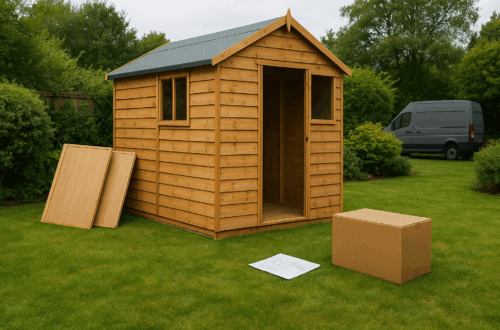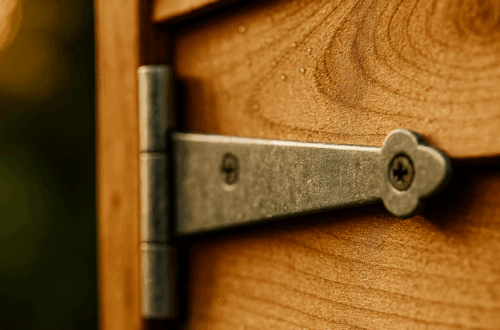Garden Sheds 2025: Choosing the Perfect Shed for Your Garden
PubPublished: 27 October 2025
Gardening is as much about creating spaces as it is about growing plants. A garden shed doesn’t merely store tools; it can be a potting corner, a home office or simply a quiet retreat. In 2025, UK gardeners have more choices than ever before, from traditional timber to smart, eco-friendly designs. This guide draws on industry insights and our allotment experience to help you pick the perfect shed.
What Size Shed Should You Choose?
Before falling in love with a design, measure your available space. Mark out the footprint with string and pegs, allowing room for the door to open and for you to walk around it. Remember that shed dimensions refer to the exterior; the interior will be slightly smaller. Think about what needs to fit inside today and in five years – it’s common to grow into a shed. Tip: Place your shed close to a fence or hedge for weather protection, but leave enough room for maintenance.
- Small (6×4 ft) – ideal for basic storage of tools and a lawnmower.
- Medium (8×6 ft) – room for bikes, gardening equipment and potting bench.
- Large (10×8 ft and up) – can double as a workshop or hobby space. Remember that planning permission may apply for large structures.
Apex vs Pent Roofs
Shed roofs are either apex (two sloping sides meeting in a peak) or pent (one sloping plane). Apex roofs provide headroom in the centre – useful if you’ll spend time inside. Pent roofs slope backwards or forwards and are often used for smaller sheds or lean-to designs. Choose a shape that fits your garden’s aesthetic and allows rain to drain away from paths.
Materials: Wood, Metal or Plastic?
Choosing the right material affects maintenance, durability and aesthetics:
- Wood is the traditional choice and blends beautifully into gardens. Look for pressure-treated timber to resist rot. Different cladding styles exist: overlap boards are rustic and budget-friendly but less weatherproof; tongue-and-groove or shiplap cladding offers tighter joints and a neater appearance. Wooden sheds need annual treatment but are repairable and customisable.
- Metal sheds provide high security and low maintenance. Quality models use galvanised steel and are less prone to rust. However, they may lack floors and require good ventilation to avoid condensation.
- Plastic sheds (resin or vinyl) are lightweight, easy to assemble and maintenance-free. They’re perfect for quick storage solutions but less customisable and may appear flimsy.
Planning & Permissions
Most sheds under 2.5 m high and covering less than half the garden do not require planning permission, but always check with your local council. If your property is listed or in a conservation area, rules are stricter. Avoid placing the shed in front of your house or too close to boundaries; inform neighbours if you need access across their land during construction.
Foundations & Base Options
A shed is only as good as its base. Common options include:
- Concrete slab – suitable for large sheds and workshops; long-lasting but requires proper formwork.
- Paving slabs – a DIY-friendly choice for medium sheds; ensure the sub-base is level.
- Timber frame (decking) – ideal for uneven ground; quick to build but must be well braced.
- Railway sleepers or eco-grids – provide a rustic or permeable base with good drainage.
Raise the floor on bearers and include a damp-proof membrane to prevent rot. Allow a small gap around the shed for airflow and maintenance.
Security & Accessories
A sturdy shed deters thieves. For wooden sheds, invest in a heavy-duty lock and secure hinges with through-bolts. Fix the roof to the frame and consider adding a metal bar across the doors. Lock expensive tools inside a separate box and install an alarm and motion-activated lights. Check whether your contents are covered by home insurance.
Useful accessories include guttering (to channel rainwater into a water butt), shelving, tool racks and even solar lighting. If you plan to use your shed as an office, run electricity via an armoured cable installed by a qualified electrician and consider insulation and double glazing.
Sustainability & Smart Trends
Shed designs are evolving. Many homeowners now seek eco-friendly options, such as reclaimed timber or recycled plastics, and solar panels for lighting. Smart sheds with IoT-enabled lighting and climate control are gaining popularity; some serve as home offices or creative studios. When choosing a shed, consider future-proof features like modular shelving, smart locks and the ability to connect to your home network.
Top Garden Sheds for 2025 (UK)
The table below showcases a selection of recommended sheds across different categories. Prices are approximate and based on UK retailers (B&Q, Wickes, Tiger Sheds and Amazon) as of October 2025.
| Category | Model & Size | Material & Features | Approx. Price (GBP) | Why It Stands Out |
|---|---|---|---|---|
| Best Overall | Rowlinson Oxford Apex 8×6 | Wooden; shiplap cladding; single door with lock; two fixed windows; pressure-treated. | £550–£600 | Balanced size for most gardens; attractive cottage style; durable timber. |
| Budget Pick | Keter Manor 6×4 Plastic Shed | Plastic (resin); lockable double door; ventilation panel; flooring included. | £320–£370 | Maintenance-free; easy assembly; good for small gardens and renters. |
| High-Security | Yardmaster Shiplap Metal Shed 10×12 | Metal; gabled roof; interior height ~2 m; optional floor kit. | £750–£800 | Large capacity and secure for tools and bikes; shiplap-style steel panels. |
| Compact Urban | Tiger Sheds Mini Store 4×3 | Timber; pent roof; single door; overlap cladding. | £250–£300 | Fits balconies or small courtyards; simple storage for tools. |
| Premium/Hobby | BillyOh Winchester Log Cabin 12×8 | Tongue-and-groove wood; double doors; large windows; optional insulation kit. | £1,300–£1,600 | Ideal for hobby room or garden office; can be insulated and wired. |
| Eco-Friendly | Forest Garden Xtend 2.5 Office Pod | Sustainably sourced wood; insulated walls; double glazing; sedum-roof option. | £3,000–£4,000 | Designed as a garden office; high energy efficiency; green roof option appeals to eco-conscious buyers. |
Note: For each shed, include an affiliate link or official retailer link if you plan to monetise the article.
Frequently Asked Questions
What base should I use for my shed?
For small to medium sheds, paving slabs or a timber frame is sufficient; for larger or heavier sheds, invest in a concrete slab.lished: 27 October 2025
Do I need planning permission for a garden shed?
Generally, no, provided the shed is under 2.5 m high, occupies less than 50 % of your garden and is for domestic use. Always verify with your local authority, especially in conservation areas or if the shed will be used as a workspace.
How do I maintain a wooden shed?
Treat timber annually with preservative paint or stain, repair damaged boards promptly and ensure the roof felt is intact. Keep vegetation clear from the shed walls to allow air circulation.
Which is better: metal or plastic sheds?
Metal sheds are more secure and durable but can suffer from condensation and usually lack floors. Plastic sheds are lightweight and maintenance-free but less customisable. Choose based on your priorities.
Can I use a shed as an office or studio?
Yes. Many modern sheds are designed as “garden rooms.” Opt for one with good insulation, double glazing and electrical fittings. If running a business, check planning rules and insurance.
Gardening is as much about creating spaces as it is about growing plants. A garden shed doesn’t merely store tools; it can be a potting corner, a home office or simply a quiet retreat. In 2025, UK gardeners have more choices than ever before, from traditional timber to smart, eco-friendly designs. This guide draws on industry insights and our allotment experience to help you pick the perfect shed.
What Size Shed Should You Choose?
Before falling in love with a design, measure your available space. Mark out the footprint with string and pegs, allowing room for the door to open and for you to walk around it. Remember that shed dimensions refer to the exterior; the interior will be slightly smaller. Think about what needs to fit inside today and in five years – it’s common to grow into a shed. Tip: Place your shed close to a fence or hedge for weather protection, but leave enough room for maintenance.
- Small (6×4 ft) – ideal for basic storage of tools and a lawnmower.
- Medium (8×6 ft) – room for bikes, gardening equipment and potting bench.
- Large (10×8 ft and up) – can double as a workshop or hobby space. Remember that planning permission may apply for large structures.
Apex vs Pent Roofs
Shed roofs are either apex (two sloping sides meeting in a peak) or pent (one sloping plane). Apex roofs provide headroom in the centre – useful if you’ll spend time inside. Pent roofs slope backwards or forwards and are often used for smaller sheds or lean-to designs. Choose a shape that fits your garden’s aesthetic and allows rain to drain away from paths.
Materials: Wood, Metal or Plastic?
Choosing the right material affects maintenance, durability and aesthetics:
- Wood is the traditional choice and blends beautifully into gardens. Look for pressure-treated timber to resist rot. Different cladding styles exist: overlap boards are rustic and budget-friendly but less weatherproof; tongue-and-groove or shiplap cladding offers tighter joints and a neater appearance. Wooden sheds need annual treatment but are repairable and customisable.
- Metal sheds provide high security and low maintenance. Quality models use galvanised steel and are less prone to rust. However, they may lack floors and require good ventilation to avoid condensation.
- Plastic sheds (resin or vinyl) are lightweight, easy to assemble and maintenance-free. They’re perfect for quick storage solutions but less customisable and may appear flimsy.
Planning & Permissions
Most sheds under 2.5 m high and covering less than half the garden do not require planning permission, but always check with your local council. If your property is listed or in a conservation area, rules are stricter. Avoid placing the shed in front of your house or too close to boundaries; inform neighbours if you need access across their land during construction.
Foundations & Base Options
A shed is only as good as its base. Common options include:
- Concrete slab – suitable for large sheds and workshops; long-lasting but requires proper formwork.
- Paving slabs – a DIY-friendly choice for medium sheds; ensure the sub-base is level.
- Timber frame (decking) – ideal for uneven ground; quick to build but must be well braced.
- Railway sleepers or eco-grids – provide a rustic or permeable base with good drainage.
Raise the floor on bearers and include a damp-proof membrane to prevent rot. Allow a small gap around the shed for airflow and maintenance.
Security & Accessories
A sturdy shed deters thieves. For wooden sheds, invest in a heavy-duty lock and secure hinges with through-bolts. Fix the roof to the frame and consider adding a metal bar across the doors. Lock expensive tools inside a separate box and install an alarm and motion-activated lights. Check whether your contents are covered by home insurance.
Useful accessories include guttering (to channel rainwater into a water butt), shelving, tool racks and even solar lighting. If you plan to use your shed as an office, run electricity via an armoured cable installed by a qualified electrician and consider insulation and double glazing.
Sustainability & Smart Trends
Shed designs are evolving. Many homeowners now seek eco-friendly options, such as reclaimed timber or recycled plastics, and solar panels for lighting. Smart sheds with IoT-enabled lighting and climate control are gaining popularity; some serve as home offices or creative studios. When choosing a shed, consider future-proof features like modular shelving, smart locks and the ability to connect to your home network.
Top Garden Sheds for 2025 (UK)
The table below showcases a selection of recommended sheds across different categories. Prices are approximate and based on UK retailers (B&Q, Wickes, Tiger Sheds and Amazon) as of October 2025.
| Category | Model & Size | Material & Features | Approx. Price (GBP) | Why It Stands Out |
|---|---|---|---|---|
| Best Overall | Rowlinson Oxford Apex 8×6 | Wooden; shiplap cladding; single door with lock; two fixed windows; pressure-treated. | £550–£600 | Balanced size for most gardens; attractive cottage style; durable timber. |
| Budget Pick | Keter Manor 6×4 Plastic Shed | Plastic (resin); lockable double door; ventilation panel; flooring included. | £320–£370 | Maintenance-free; easy assembly; good for small gardens and renters. |
| High-Security | Yardmaster Shiplap Metal Shed 10×12 | Metal; gabled roof; interior height ~2 m; optional floor kit. | £750–£800 | Large capacity and secure for tools and bikes; shiplap-style steel panels. |
| Compact Urban | Tiger Sheds Mini Store 4×3 | Timber; pent roof; single door; overlap cladding. | £250–£300 | Fits balconies or small courtyards; simple storage for tools. |
| Premium/Hobby | BillyOh Winchester Log Cabin 12×8 | Tongue-and-groove wood; double doors; large windows; optional insulation kit. | £1,300–£1,600 | Ideal for hobby room or garden office; can be insulated and wired. |
| Eco-Friendly | Forest Garden Xtend 2.5 Office Pod | Sustainably sourced wood; insulated walls; double glazing; sedum-roof option. | £3,000–£4,000 | Designed as a garden office; high energy efficiency; green roof option appeals to eco-conscious buyers. |
Note: For each shed, include an affiliate link or official retailer link if you plan to monetise the article.
Frequently Asked Questions
- Do I need planning permission for a garden shed?
Generally, no, provided the shed is under 2.5 m high, occupies less than 50 % of your garden and is for domestic use. Always verify with your local authority, especially in conservation areas or if the shed will be used as a workspace. - How do I maintain a wooden shed?
Treat timber annually with preservative paint or stain, repair damaged boards promptly and ensure the roof felt is intact. Keep vegetation clear from the shed walls to allow air circulation. - Which is better: metal or plastic sheds?
Metal sheds are more secure and durable but can suffer from condensation and usually lack floors. Plastic sheds are lightweight and maintenance-free but less customisable. Choose based on your priorities. - Can I use a shed as an office or studio?
Yes. Many modern sheds are designed as “garden rooms.” Opt for one with good insulation, double glazing and electrical fittings. If running a business, check planning rules and insurance. - What base should I use for my shed?
For small to medium sheds, paving slabs or a timber frame is sufficient; for larger or heavier sheds, invest in a concrete slab.




